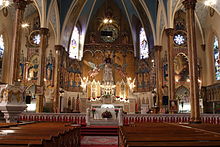
The Archdiocese of Detroit is a Latin Church ecclesiastical territory or archdiocese of the Catholic Church covering the Michigan counties of Lapeer, Macomb, Monroe, Oakland, St. Clair, and Wayne. It is the metropolitan archdiocese of the Ecclesiastical Province of Detroit, which includes all dioceses in the state of Michigan. In addition, in 2000 the archdiocese accepted pastoral responsibility for the Catholic Church in the Cayman Islands, which consists of Saint Ignatius Parish on Grand Cayman.
Poletown East is an industrial district of Detroit, Michigan, bordering the enclave city of Hamtramck. The area was named after the Polish immigrants who originally lived in the area. A portion of residential area known as Poletown became the General Motors Detroit/Hamtramck Assembly plant in 1981 with those residents relocated by General Motors and the cities of Detroit and Hamtramck which claimed eminent domain in order to make way for a new automobile plant.

Polish Americans are Americans who either have total or partial Polish ancestry, or are citizens of the Republic of Poland. There are an estimated 8.81 million self-identified Polish Americans, representing about 2.67% of the U.S. population, according to the 2021 American Community Survey conducted by the U.S. Census Bureau. Polish Americans are the second-largest Central European ethnic group after German Americans, and the eighth largest ethnic group overall in the United States.
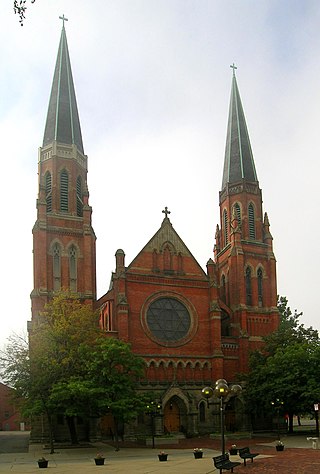
Basilica of Sainte Anne de Détroit (Sainte-Anne-de-Détroit) was founded July 26, 1701 by French colonists in New France, and is the second-oldest continuously operating Roman Catholic parish in the United States. The current Gothic Revival cathedral-styled church, built in 1886, is located at 1000 St. Anne Street in Detroit, Michigan, in the Hubbard-Richard neighborhood, near the Ambassador Bridge, and the Michigan Central Station. At one time it was the seat of a diocese that included French territory in Ontario, Canada south of the Detroit River.

St. Florian Church is a Roman Catholic Church at 2626 Poland Street in Hamtramck, Michigan. The church was designed by Ralph Adams Cram of the firm Cram and Ferguson.

Holy Redeemer High School was a Roman Catholic secondary school located in Southwest Detroit, at the corner of Junction and Vernor streets, near the Ambassador Bridge to Canada. It was overseen by the Archdiocese of Detroit.
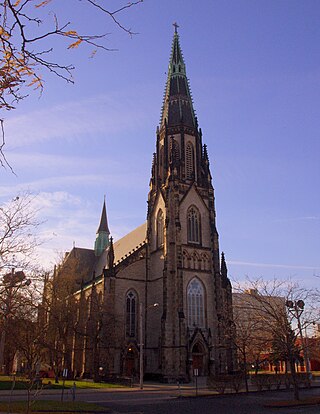
St. Joseph Shrine, founded in 1855, is a historic German Catholic church located at 1828 Jay Street in the Eastern Market–Lafayette Park neighborhood area just outside downtown Detroit, Michigan, on the city's central east side. The building was listed on the National Register of Historic Places in 1972, and deemed "of national importance" because of its stained glass. Three subsidiary buildings—the rectory, convent, and the Wermers House—were added to the listing in 1992. It is under the jurisdiction of the Archdiocese of Detroit, and presently a shrine dedicated to the celebration of the pre-Vatican II liturgy under the care of the canons of the Institute of Christ the King Sovereign Priest.
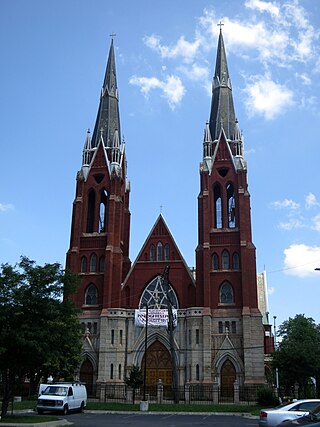
The Sweetest Heart of Mary Roman Catholic Church is located at 4440 Russell Street in Detroit, Michigan, in the Forest Park neighborhood on the city's central East side. The Gothic Revival cathedral styled church is the largest of the Roman Catholic churches in the City of Detroit. It was designated a Michigan State Historic Site in 1974 and listed on the National Register of Historic Places in 1978. It, along with St. Albertus Roman Catholic Church, 0.4 miles east on East Canfield Street, and St. Josaphat Roman Catholic Church, 0.3 miles west at East Canfield Street and Chrysler Drive, served the large Polish community through most of the twentieth century. In a diocesan reorganization instituted by Archbishop Allen Vigneron in 2013, Sweetest Heart of Mary joined with St. Josephat to form Mother of Divine Mercy Parish.

The Sacred Heart Roman Catholic Church, Convent and Rectory is a Roman Catholic church complex located at 1000 Eliot Street in Detroit, Michigan. It was designated a Michigan State Historic Site in 1975 and listed on the National Register of Historic Places in 1980.

The Chapel of St. Theresa–the Little Flower is a church located at 58 Parsons Street in Midtown Detroit, Michigan. It is currently known as St. Patrick Church. The building was listed on the National Register of Historic Places in 1997.

Sts. Peter and Paul Academy is a Catholic school building located at 64 Parsons Street in Midtown Detroit, Michigan. It currently serves as the St. Patrick Senior Center. It was listed on the National Register of Historic Places in 1997.
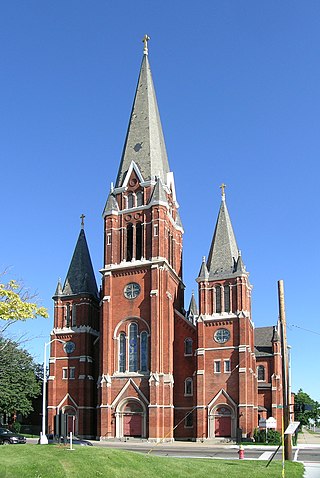
St. Josaphat Roman Catholic Church is a Roman Catholic church located at 715 East Canfield Street in Detroit, Michigan. It was listed on the National Register of Historic Places in 1982 and designated a Michigan State Historic Site in 1985. Since 2013, it has been one of two churches that comprise Mother of Divine Mercy Parish.

The Most Holy Redeemer Church is located at 1721 Junction Street in Southwest Detroit, Michigan, within the West Vernor–Junction Historic District. The church was once estimated as the largest Roman Catholic parish in North America. West Vernor–Junction Historic District is adjacent to Mexicantown and contains a growing Mexican community and resurgent neighborhood.

St. Mary Roman Catholic Church, formally the Church of the Immaculate Conception of the Blessed Virgin Mary, is in the third oldest Roman Catholic parish in Detroit, Michigan. Designed by German-born Peter Dederichs and built for the formerly ethnic German parish of the 19th century, it is located at 646 Monroe Street in what is now considered the heart of the Greektown Historic District in downtown Detroit. It is often called "Old St. Mary's Church" to avoid confusion with other St. Mary's parishes: in the Redford neighborhood of Detroit, or in nearby Royal Oak, Monroe, or Wayne.
Joseph Casimir Plagens was a Polish-born prelate of the Roman Catholic Church. He served as bishop of the Diocese of Grand Rapids in Michigan from 1941 to 1943.
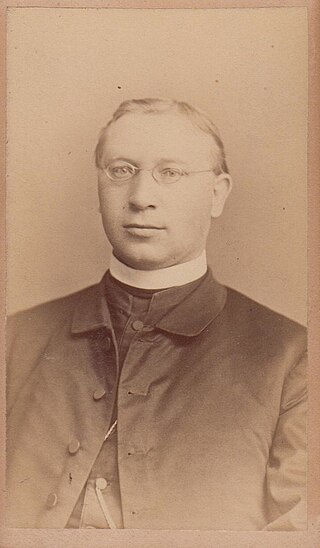
Jan Romuald Byzewski, better known in America as Father Romuald Byzewski, was born in the Kaszubian village of Karwia, in the Prussian jurisdiction of Danzig (Gdansk), on October 10, 1842.
Józef Franciszek Darzyn Ciemiński was a Polish-born Roman Catholic priest. He emigrated with his parents to the United States in 1881 and was ordained as a Priest in Saint Paul, Minnesota in 1895. He was involved with numerous Polish Catholic parishes during his lifetime including the now closed troubled Parish of Saints Peter and Paul in Duluth, Minnesota, and the parish of Holy Cross in Minneapolis.
St. Casimir Church is a parish church of the Roman Catholic Archdiocese of Baltimore located in the Canton neighborhood of Baltimore, Maryland.

Events from the year 1885 in Michigan.

Our Lady of Mt. Carmel is a Roman Catholic church in Bayonne, New Jersey. The name is a dedication to the Blessed Virgin Mary in her role as patroness of the Carmelite Order, hence the name Our Lady of Mount Carmel. Founded by Polish immigrants in 1898, it grew to become one of the largest Polish congregation in the United States. Part of the Archdiocese of Newark, the parish merged with two others to become the Parish of St. John Paul II in 2016.

